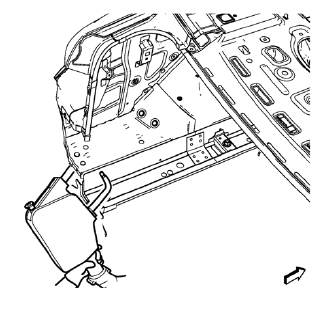Chevrolet Cruze Repair Manual: Installation Procedure

- Cut the rear side rail in corresponding locations to fit the remaining original panel. The sectioning joint should be trimmed to allow a gap of one-and-one-half-times the metal thickness at the sectioning joint.
- Create a 50 mm (2 in) backing plate from the unused portion of the service part.
- Create 5 x 18 mm (4/16 x 11/16) slots for MIG-brazing along the sectioning cut on the remaining original part. Locate these holes 13 mm (1/2 in) from the edge of part and spaced 40 mm (1½ in) apart.
- Prepare all mating surfaces as necessary.
- Fit the backing plates halfway into the sectioning joints, clamp in place and braze to the vehicle.
- Align the rear side rail.
- Clean and prepare the attaching surfaces for brazing and spot welding.
Note: In MIG-brazing areas 50 mm (2 in) must be kept clear of structural adhesive.
- Apply structural adhesive to all attaching surfaces.

- Position the rear side rail on the vehicle.
- Verify the fit of the rear side rail.
- Clamp the rear side rail into position.

- Braze accordingly.
- To create a solid braze with minimum heat distortion, make 25 mm (1 in) stitch brazes along the seam with 25 mm (1 in) gaps between them. Then go back and complete the stitch braze.

- Spot weld accordingly.
- Apply the sealers and anti-corrosion materials to the repair area, as necessary. Refer to Anti-Corrosion Treatment and Repair.
- Paint the repaired area. Refer to Basecoat/Clearcoat Paint Systems.
- Install all related panels and components.
- Connect the negative battery cable. Refer to Battery Negative Cable Disconnection and Connection.
- Enable the SIR system. Refer to SIR Disabling and Enabling.
 Removal Procedure
Removal Procedure
Warning: Refer to Approved Equipment for Collision Repair Warning in the
Preface section.
Warning: Refer to Collision Sectioning Warning in the Preface section.
Warning: Refer to Glass and She ...
 Underbody Rear Side Rail Reinforcement Replacement (MAG-Welding)
Underbody Rear Side Rail Reinforcement Replacement (MAG-Welding)
Note: According to different corrosion warranties, only the
regional mandatory joining methods are allowed. ...
Other materials:
Front Seat Belt System
The front seat belt system includes a driver and passenger seat belt
pretensioner retractor. Both front seat belt pretensioners includes a
seat belt switch in the seat buckle which controls a reminder lamp and a tone
alarm.
Note: The front passenger seat is equipped with a passenger
presence ...
Headlining Trim Panel Replacement (With Sunroof)
Warning: Do not attempt to repair or alter the head impact
energy-absorbing material glued to the headliner or to the garnish
trims. If the material is damaged, replace the headliner and/or the garnish
trim. Failure to do so could result in personal injury.
Caution: If a vehicle is equip ...
Headlamp Aiming Procedure
Open the hood.
Measure from the floor to the center of the headlamp bulb. Some
headlamps have an aim dot marked on the headlamp lens.
At the screen, measure from the floor and place the horizontal tape at
the measured distance.
Measure from the reference line on the floor to the le ...
